Boys AT Rifle
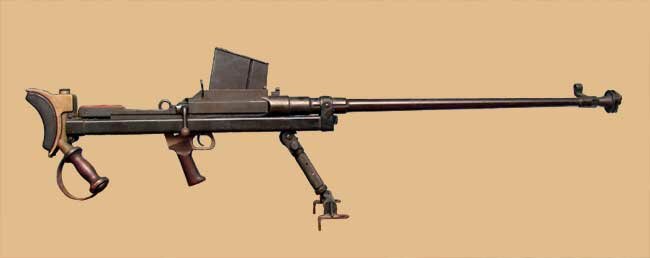
Boys Mk1 AT Rifle
With the increased interest in tanks in the late 1920's and early 1930's it quickly became apparent that the infantry would need a platoon weapon to counter the armor threat. What most armies looked for were similar weapons to the Mauser Anti-tank (AT) Rifle developed by the Germans at the end of World War I.
The idea behind an AT rifle is to punch a solid hole through an armored vehicles hull by using a high velocity round. Once the round punches through, it will rattle around the inside and do major damage to the crew and any equipment it manages to make contact with. While it may sound odd that a .55 caliber (14 mm) round could stop a tank, the Mauser AT rifle of WWI fired a 7.92mm round. What made the round effective was it's velocity and its penetrating power. Typically AT rounds were tungsten core rounds which allow them to penetrate steel where other rounds would have bounced off.
Design of the Boys (sometimes incorrectly spelled Boyes) AT Rifles began in 1934 and it was officially adopted in 1937. At the time of introduction, the Boys could actually defeat the armor of virtually every tank in existence. Initially the gun was known as the Stantion Gun but was given the name Boys when it's inventor died. The rifle was never popular among the troops not because it was ineffective but because it was extremely loud and had a horrendous recoil. Indeed its recoil was such that it earned the not so affection nick-name "Charlie the Bastard". If one did not hold on tight, the rifle would definitely result in a bruised or dislocated shoulder.
By 1940, many of the armies of the world had developed tanks that made AT rifles obsolete. Fortunately for the British, two of their main adversaries still operated some tanks that were as obsolete as the Boys AT rifle. The armor of several Italian tank could be penetrated by the Boys AT rifle, as could most Japanese tanks. It was also capable of penetrating the armor of some German armored cars as well as Panzer I tanks. So while the AT rifle had really out lived it usefulness in most places, it was still a somewhat effective weapon in the Western Desert.
And it could also be used against fortified positions. Its armor piercing round doing effective work against concrete emplacements fuel trucks and parked aircraft!
The major drawback of the Boys, other than its recoil and report was that it was a bolt action rifle giving it a slow rate of fire. Mounting the rifle on a vehicle solved the recoil problem and increased its accuracy. The rifle was often mounted on armoured cars in universal carriers in place of a machine gun.
The LRDG considered the weapon somewhat useless for three main reasons. It was heavy, it had a slow rate of fire and patrols normally were able to avoid enemy armor. Once they were able to acquire .50 MGs, the Boys rifle was normally not carried. This would lead to some problems during the Barce raid, as the Vickers Mk. V 1/2 inch was not capable of penetrating the 14mm frontal armor of L3 tanks whereas the Boys AT rifle could have. As it was the raiding party had to ram L3 tanks with their trucks, on at least two occasions, in order to withdraw from the city after the raid. This disabled the trucks and eventually left the patrol with only two vehicles for the long ride home.
-- See Also "Stop That Tank" A 1942 movie produced for Canada by Disney.
Boys AT Rifle Specifications
- Ammunition: .55 in. (14 mm) AP
- Action: Single shot, bolt operated
- Overall length: 63.7 in. (161.8 cm)
- Barrel: 36 in. (91.4 cm)
- Weight 36 lbs 8 oz (16.5kg)
- Muzzle velocity: 3250 FPS*
- Projectile weight: 3 oz.
- Armor Penetration: 1in (2.54 cm) and 100 meters / 1/2 in (1.3 cm) at 500 meters
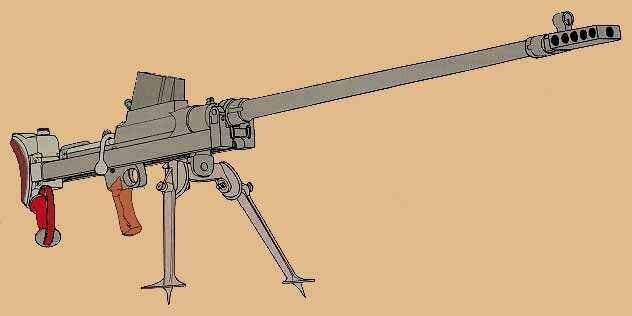
Boys Mk. II AT rifle
Technical drawing of the Boys AT rifle. Orininal line art (in B&W) found in the book:
- Secret Warfare: the Arms and Techniques of the Resistance
- Lorain, Pierre.
- London : Orbis Publishing
See Sources. This book is an excellent source on weapons and other equipment used by commandos and other WWII Special Forces.
OML 2 Inch Mortar
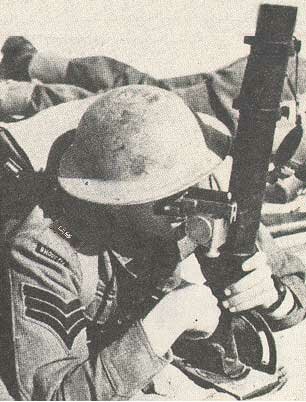
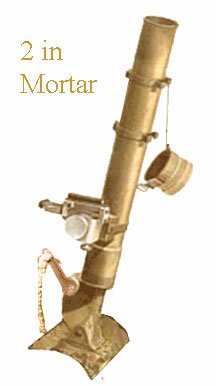
Each LRDG Truck carried a 2 inch mortar (Approximately a 51mm round) The weapon consisted of a gun tube and base plate that was either a flat plate or a rounded spade. The spade was eventually replaced. The flat plate could be placed under the operators boot. It was quick an easy to use, with a high rate of fire.
This ordnance was introduced into service in January 1939. Used throughout World War 2 in three different versions, Infantry, Airborne and Carrier which differ in minor details and consisted of a barrel, breech piece and spade or base plate (carrier version)
Ammunition
- High Explosive (HE)
- Smoke (SMK)
- Illumination (ILLUM)
- Practice
- Signal [Multiple Varieties],
- Smoke WP [Experimental Only]
- Range: 525 yards
* While some sources say each truck carried a 2 inch mortar, others say that each patrol had a 2 inch mortar. Chrichton-Stuart even explains how G Patrol borrowed a 2 inch mortar from another patrol so that his patrol could use both mortars in support of an action. It may be that a one time, patrols were given one mortar per patrol and that later changed to one mortar per truck; or some sources may be wrong.
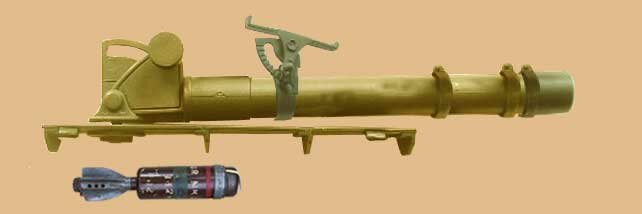
2 inch mortar in carrying position, with simple sight and muzzle cap.
2 inch HE mortar shell (bomb) also displayed.
20 MM Modello 35 Breda AA/AT gun
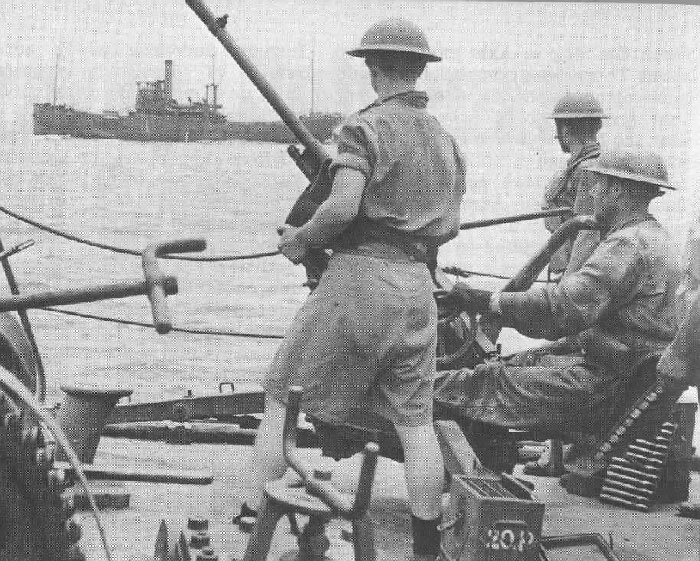
British troops in Tobruk man a Breda mounted on a barge. Note the 12 round strips.
- 20 MM Breda Specifications:
- Ammo : HE Tracer
- Ammunition Feed : 12 rd strips
- Muzzle Velocity : 2800 fps
- Cyclic Rate of Fire : 220 rpm
- Effective Rate of Fire : 150 rpm
- Effective Ceiling : 2200 meters
The Italian Breda 20 mm AT/AA gun was an improvement over the heavier, slower firing 3.7cm Bofors AT Gun originally carried by patrols.
Unlike many Italian machine guns, this automatic cannon was extremely effective and rivaled the guns of other nations. The Germans even used them when they refitted Panzer IIs as recon vehicles. It fired from a loose belt or hundred round belts stored in canister.
The 20mm round was almost half the size of the Bofors AT Gun, yet it was still capable of defeating Italian tanks and many light German tanks.
It's chief advantage, however was the 12 round strip feed* , automatic fire, and use against both air and ground targets.
*I've read it used a box magazine, drum feed, and belt feed, however all photographic evidence suggest it was strip fed. This method of feed was also common among Italian MGs.
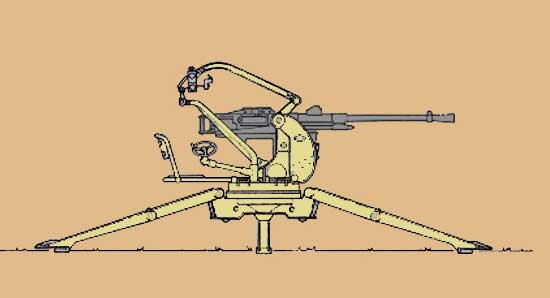
Side view of the Breda AA gun
3.7CM Bofors AT Gun
The Bofors AT gun was a single shot gun designed to defeat armor targets. It was obsolete by 1941 but was still capable of defeating most of the armor vehicles being used in the desert campaign. The Bofors was a very popular gun and was made under license or copied by numerous European nations as well as the United States. In Poland it was known as the Wz36. The modified US version was known as the M3A1. This gun was further modified and was used as the main gun on the Stuart Tank. In Britain it was the QF (Quick Fire) 37mm Mk I.
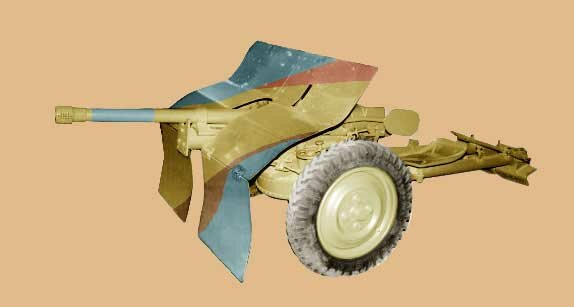
Effective against light armor at short distances, it lacked the sorely needed anti-aircraft capabilities needed by the LRDG. It was therefore replaced by the Breda above.
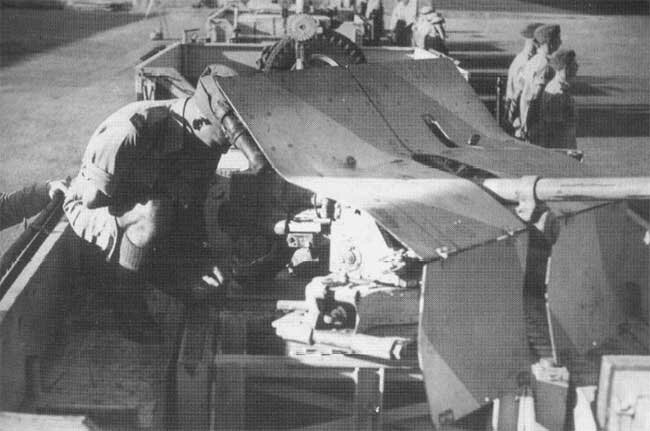
Bofors Truck with a view of the mount for the gun.
Read more about weapons:
